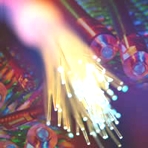|
Fiber
optic cabling can be used in both the horizontal
(desktop) and backbone sections of the cabling
infrastructure. However, fiber is predominantly used in
the backbone, which links together either the floors of
a building or wide spread area's within the network.
|
| |
|
Because
of the low loss, high bandwidth properties of fiber
cable they can be used over greater distances
than copper cables, in data networks this can be
as much as 2km without the use of repeaters.
Their light weight and small size also make them
ideal for applications where running copper
cables would be impractical. The real benefits
in the data industry are its immunity to Electro
Magnetic Interference (EMI), and that the fiber
is made of glass filament which is not an
electrical conductor. |
| |
| Because
fiber is non-conductive, it can be used where |
|
|
electrical
isolation is needed, for instance between buildings
where copper cables would require cross bonding to
eliminate differences in earth potentials. Fibers also
pose no threat in dangerous environments such as
chemical plants where a spark could trigger an
explosion. Last but not least is the security aspect, it
is very, very difficult to tap into a fiber cable to
read the data signals. |
| |
|
Fiber
to the desktop is becoming more common as bandwidth
requirements increase and it is also now becoming a cost
effective alternative to copper cabling. Redundancy is
often catered for with fiber optic cables as it is far
more cost effective to provide additional cores unused
at the time of installation than at a later date when
more bandwidth is required or damage to the network has
occurred. |


